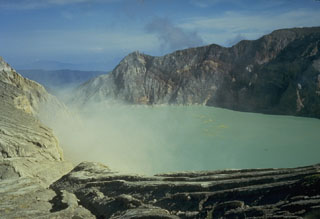Report on Ijen (Indonesia) — 15 January-21 January 2020
Smithsonian Institution / US Geological Survey
Weekly Volcanic Activity Report, 15 January-21 January 2020
Managing Editor: Sally Sennert.
Please cite this report as:
Global Volcanism Program, 2020. Report on Ijen (Indonesia) (Sennert, S, ed.). Weekly Volcanic Activity Report, 15 January-21 January 2020. Smithsonian Institution and US Geological Survey.
Ijen
Indonesia
8.058°S, 114.242°E; summit elev. 2769 m
All times are local (unless otherwise noted)
PVMBG reported that during 1-18 January white plumes rose 250-400 m above Ijen’s water lake surface and no change in the color of the water was noted. An increase in the number of shallow volcanic earthquakes was detected; continuous tremor emerged on 11 January, peaked on 15 January, and then decreased during 17-18 January. The temperature of the lake water fluctuated, though overall it decreased from 38 degrees Celsius in June 2019 to 20 degrees Celsius on 14 January; the lake water was 46 degrees Celsius during a period of increased activity from February to March 2018. The Alert Level remained at 1 (on a scale of 1-4), and residents and visitors were advised to not approach the crater rim or descend to the crater floor.
Geological Summary. The Ijen volcano complex at the eastern end of Java consists of a group of small stratovolcanoes constructed within the 20-km-wide Ijen (Kendeng) caldera. The north caldera wall forms a prominent arcuate ridge, but elsewhere the rim was buried by post-caldera volcanoes, including Gunung Merapi, which forms the high point of the complex. Immediately west of the Gunung Merapi stratovolcano is the historically active Kawah Ijen crater, which contains a nearly 1-km-wide, turquoise-colored, acid lake. Kawah Ijen is the site of a labor-intensive mining operation in which baskets of sulfur are hand-carried from the crater floor. Many other post-caldera cones and craters are located within the caldera or along its rim. The largest concentration of cones forms an E-W zone across the southern side of the caldera. Coffee plantations cover much of the caldera floor; nearby waterfalls and hot springs are tourist destinations.
Source: Pusat Vulkanologi dan Mitigasi Bencana Geologi (PVMBG, also known as CVGHM)

